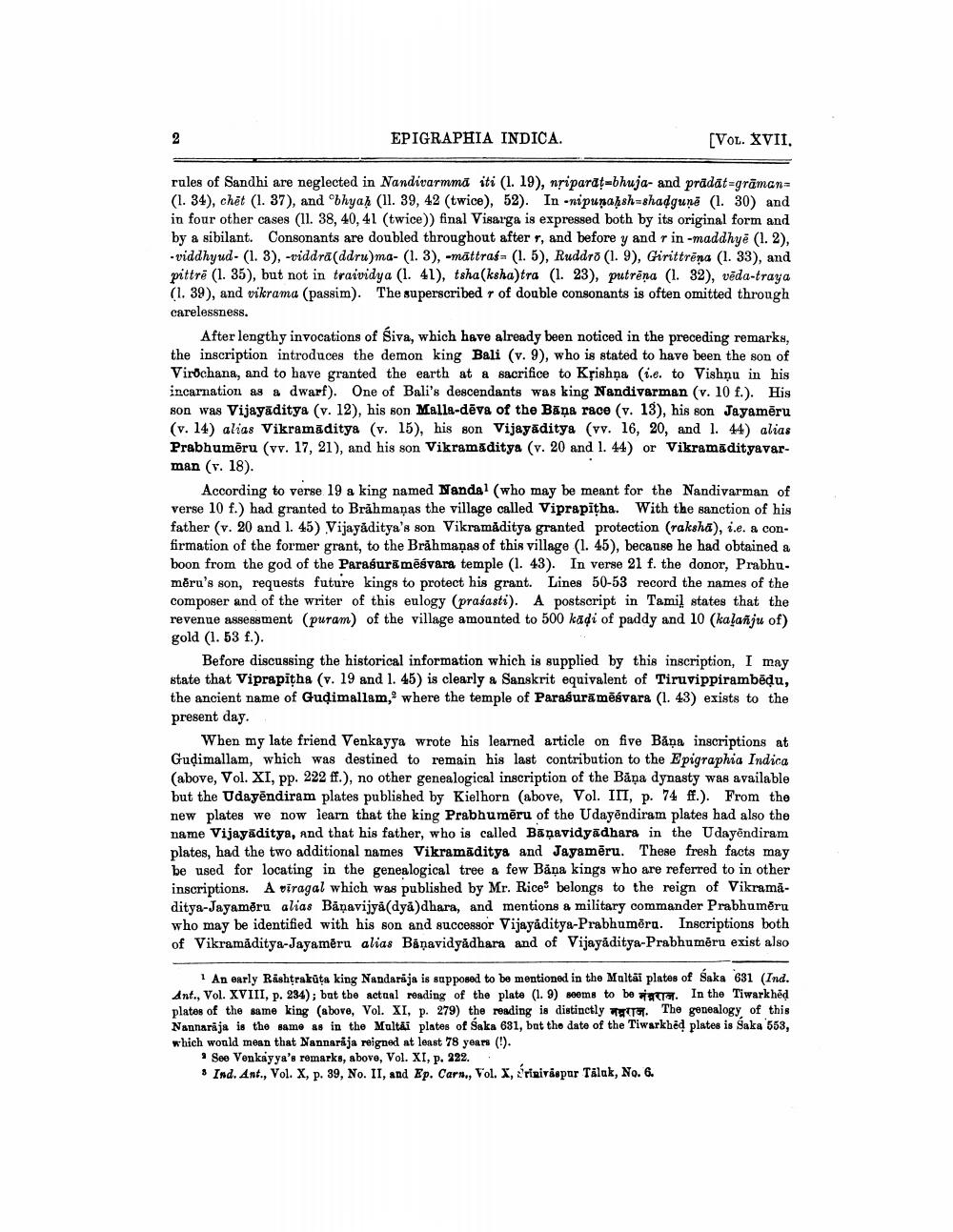________________
EPIGRAPHIA INDICA.
[VOL. XVII.
rules of Sandhi are neglected in Nandivarmmā iti (1. 19), nsiparaţ=bhuja- and prādāt=grāman(1. 34), chet (1. 37), and "bhyah (1l. 39, 42 (twice), 52). In-nipuñash=shadguni (1. 30) and in four other cases (11. 38, 40, 41 (twice)) final Visarga is expressed both by its original form and by a sibilant. Consonants are doubled throughout after r, and before y and r in-maddhye (1.2), - viddhyud- (1. 3), -viddrā(ddru)ma- (1. 3), -māttras= (1. 5), Ruddrā (1. 9), Girittrēna (1. 33), and pittré (1. 35), but not in traividya (1. 41), tsha(ksha)tra (1. 23), putrēna (1. 32), vēda-traya (1. 39), and vikrama (passim). The superscribed r of double consonants is often omitted through carelessness.
After lengthy invocations of siva, which have already been noticed in the preceding remarks, the inscription introduces the demon king Bali (v. 9), who is stated to have been the son of Virochana, and to have granted the earth at a sacrifice to Krishna (i.e. to Vishnu in his incarnation as a dwarf). One of Bali's descendants was king Nandivarman (v. 10 f.). His son was Vijayaditya (v. 12), his son Malle-dēva of the Bāņa race (v. 13), his son Jayamēru (v. 14) alias Vikramaditya (v. 15), his son Vijayāditya (vv. 16, 20, and l. 44) alias Prabhumēru (vv. 17, 21), and his son Vikramaditya (v. 20 and 1. 44) or Vikramadityavarman (v. 18).
According to verse 19 a king named Nandal (who may be meant for the Nandivarman of verse 10 f.) had granted to Brāhmaṇas the village called Viprapitha. With the sanction of his father (v. 20 and 1. 45) Vijayaditya's son Vikramåditya granted protection (raksha), i.e. a confirmation of the former grant, to the Brāhmaṇas of this village (1. 45), because he had obtained a boon from the god of the Parasurā mēsvara temple (1. 43). In verse 21 f. the donor, Prabhu. mēru's son, requests future kings to protect his grant. Lines 50-53 record the names of the composer and of the writer of this eulogy (prasasti). A postscript in Tamil states that the revenue assessment (puram) of the village amounted to 500 kadi of paddy and 10 (kalañju of) gold (1. 53 f.).
Before discussing the historical information which is supplied by this inscription, I may state that Viprapitha (v. 19 and 1. 45) is clearly a Sanskrit equivalent of Tiruvippirambēdu, the ancient name of Guļimallam, where the temple of Parasurāmēsvara (1. 43) exists to the present day.
When my late friend Venkayya wrote his learned article on five Băņa inscriptions at Gudimallam, which was destined to remain his last contribution to the Epigraphia Indica (above, Vol. XI, pp. 222 ff.), no other genealogical inscription of the Băņa dynasty was available but the Udayēndiram plates published by Kielhorn (above, Vol. III, p. 74 ff.). From the new plates we now learn that the king Prabhumēru of the Udayêndiram plates had also the name Vijayāditya, and that his father, who is called Bāņavidyādhara in the Udayêndiram plates, had the two additional names Vikramāditya and Jayamēru. These fresh facts may be used for locating in the genealogical tree a few Båņa kings who are referred to in other inscriptions. A viragal which was published by Mr. Rice belongs to the reign of Vikramaditya-Jayamēru alias Bånavijyä(dya)dhara, and mentions a military commander Prabhuměru who may be identified with his son and successor Vijayaditya-Prabhumora. Inscriptions both of Vikramaditya-Jayamēru alias Bäņavidyadhara and of Vijayaditya-Prabhumēru exist also
1 An early Rashtrakūta king Nandarijn is supposed to be mentioned in the Maltai plates of Saka 631 (Ind. Ant., Vol. XVIII, p. 234); but the actual reading of the plate (1.9) seems to be an. In the Tiwarkhed plates of the same king (above, Vol. XI, p. 279) the reading is distinctly WTS. The genealogy, of this Nannaraja is the same as in the Multai plates of Saka 681, but the date of the Tiwarkhed plates is Saka 553, which would mean that Nannaråja reigned at least 78 years (!).
. See Venkayya's remarks, above, Vol. XI, p. 222. . & Ind. Ant., Vol. X, p. 39, No. II, and Ep. Carn., Vol. x, Arinivaspar Tálak, No. 6.




